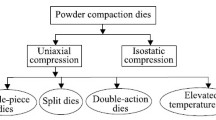A comparative study is conducted by compaction experiments and finite element simulations on the compaction behavior of multiple alloy powders in the traditional single direction compaction and in the friction-assisted-compaction processes. The results suggest that, in the single direction compaction, stress, strain, and density of the green compacts along the vertical direction are not uniform due to the effects of the friction between the side die wall and powder particles; the density on the top of the green compacts is higher than that in the bottom. However, in the friction assisted compaction process, the density distribution along the vertical direction is more uniform and the density near the middle part of the green compacts is only slightly lower than that at the top and bottom parts of the green compact.










Similar content being viewed by others
References
S. M. Tahir and A. K. Ariffin, “Fracture in metal powder compaction,” Int. J. Solids Struct., 43, No. 6, 528–1542 (2006).
Kazuyoshi Sato, Hiroya Abe, Makio Naito, et al., “Structure of strength-limiting flaws in alumina ceramics made by the powder granule compaction process,” Adv. Powder Technol., 17, No. 2, 219–228 (2006).
Poquillon, V. Baco-Carles, Tailhades, and E. Andrieu, “Cold compaction of iron powders—relations between powder morphology and mechanical properties. Part II. Bending tests: results and analysis,” Powder Technol., 126, No. 1, 75–84 (2002).
A. R. Khoei, Sh. Keshavarz, and A. R. Khaloo, “Modeling of large deformation frictional contact in powder compaction processes,” Appl. Math. Modell., 32, No. 5, 775–801 (2008).
Y. Z. Zhu and Z. M. Yin, “Pressing vacuum sintering of multipowders for manufacturing novel engine valve seat on Gleeble 1500 simulator,” Powder Metall., No. 1, 42–48 (2009).
S. S. M. Nor, M. M. Rahman, F. Tarlochan, et al., “The effect of lubrication in reducing net friction in warm powder compaction process,” J. Mater. Press. Technol., 207, No. 1–3, 118–124, (2008).
M. S. Kadiri, A. Michrafy, and J. A. Dodds, “Pharmaceutical powders compaction: Experimental and numerical analysis of the density distribution,” Powder Technol., 157, No. 1–3, 176–182 (2005).
W. Bier, M. P. Dariel, N. Frage, et al., “Die compaction of copper powder designed for material parameter identification,” Int. J. Mech. Sci., 49, No. 6, 766–777 (2007).
A. R. Khoei, A. Shamloo, and A. R. Azami, “Extended finite element method in plasticity forming of powder compaction with contact friction,” Int. J. Solids Struct., 43, No. 18–19, 5421–5448 (2006).
Sh. Keshavarz, A. R. Khoei, and A. R. Khaloo, “Contact friction simulation in powder compaction process based on the penalty approach,” Mater. Des., No. 6, 1199–1211 (2008).
T. Canta and D. Frunza, “Friction-assisted pressing of PM components,” J. Mater. Process. Technol., 143–144, 645–650 (2003).
I. D. Radomysel’skii and E. L. Pechentkovskii, “Effect of pressing tool design on density distribution in bushing-type sintered parts,” Powder Metall. Met. Ceram., 9, No. 4, 277–281 (1970).
M. B. Shtern, E. L. Pechentkovskii, I. D. Radomysel’skii, et al., “Effect of mode of pressing on the stressed-strained state of bushing—type parts,” Powder Metall. Met. Ceram., 17, No. 5, 12–17 (1978).
I. D. Radomysel’skii, E. L. Pechentkovskii, G. G. Serdyuk, et al., “Density distribution and powder displacement in pressing in closed dies,” Powder Metall. Met. Ceram., 21, No. 1, 8–12 (1982).
L. S. Boginskii, G. M. Zhdanovich, and Ch. A. Yakubovskii, “Pressing of metal powders by the “moving pin” method,” Powder Metall. Met. Ceram., 15, No. 6, 429–434 (1976).
Y. Z. Zhu, Z. M. Yin, Z. D. Xiang, and Z. Zhe, “Cold densification behavior of multiple alloy powder containing Fe–Cr and Fe–Mo hard particles,” Powder Metall., No. 2, P. 143–149 (2008).
S. P. Machado and V. H. Cortinez, “Non-linear model for stability of thin-walled composite beams with shear deformation,” Thin-Walled Struct., 43, No. 10, 1615–1645 (2005).
Acknowledgements
This work is supported by The National Natural Science Foundation of China (No. 50874083), the Foundation for Distinguished Young Scientists of Hubei Province of China (No. 2009CDA044), and the Foundation of Hu’bei Educational Committee (No. Q20091110).
Author information
Authors and Affiliations
Corresponding author
Additional information
Translated from Poroshkovaya Metallurgiya, Vol. 50, No. 9–10 (481), pp. 20–30, 2011.
Rights and permissions
About this article
Cite this article
Zhu, Y., Li, J., Liang, D. et al. Comparison study of single direction and friction assisted compaction of multiple alloy powders by finite element simulation. Powder Metall Met Ceram 50, 586–595 (2012). https://doi.org/10.1007/s11106-012-9364-y
Received:
Published:
Issue Date:
DOI: https://doi.org/10.1007/s11106-012-9364-y




